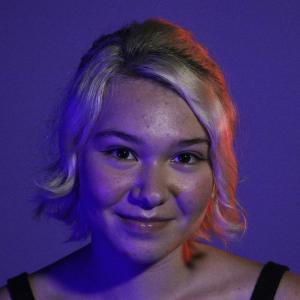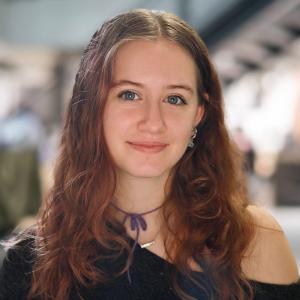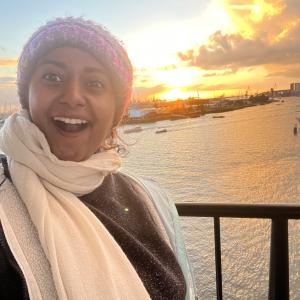Oberlin Blogs
8 questions for 8 Oberlin alums - part 3
March 1, 2009
Joe Dawson ’12
Welcome to part 3! In this episode, our heroes answer questions about creativity in teaching and working with students. In case you missed it, here's Part 1, here's Part 2.
7. In what ways do you get to be creative in your work?
8. What was your latest collaboration with a student?
Thanks for coming, gee it's getting late... Sure, you can stick around for a while. I have some Michael McDonald records we could listen to. Oh no? Well, we should do this again sometime. Um, yeah...
Big thanks to Wendy Kozol, Booker Peek, John Petersen, William Patrick Day, Amy Margaris, Leonard Smith, Bill Friedman, and Bruce Richards.
7. In what ways do you get to be creative in your work?
- "My work is interdisciplinary and combines traditional archaeology, ethnohistory, and engineering. Devising recipes which successfully blend data from these disciplines is always a creative endeavor. My students and I research the design and uses of prehistoric and early historic technologies, particularly those constructed from biological tissues like bone and antler." (Amy Margaris '96)
- "I can't think of many ways in which teaching and research are NOT creative. Devising new ways to present the subject matter of a course so that it is most clear to students requires great creativity. Designing a research experiment is a very creative process. Giving students good advice requires creativity. Coming up with good examination questions is a creative process. Writing memos, reports, research documents, and other such things is a creative process." (Bruce Richards '61)
- "All ways. Teaching, research, civic engagement, the room for creativity here is endless. My students and I have created the Campus Resource Monitoring System and this last year we won a national award for developing the 'Energy Orb' - it was rated best energy efficiency appliance of the year. In 2004 a group of students who worked with me founded Lucid Design Group which has now developed resource use monitoring and display systems for schools all over the country. The opportunity for creatively engaging with Oberlin students and the larger community are nearly endless. We are creating models in Oberlin that we hope others will follow." (John Petersen '88)
- "Research is my primary creative outlet. Identifying important issues,coming up with ways to address them, and interpreting findings are all creative acts. What I do day to day is superficially quite different from what my artist wife does, but at a deeper level, we are both constantly seeking new ideas and trying to find out what, in reality, works." (Bill Friedman '72)
- "Because I work both with college students and with children in grades K-12, I have a most challenging but also a most exciting job, one in which theory and practice are forever intertwined, with the one informing the other incessantly. At all times the job requires me to be creative, imaginative, and flexible. There's never a second where I can actually get settled in, comfortable with things." (Booker Peek '66)
- "To communicate effectively requires various skills, but it also requires creativity in seeking ways to express complex ideas. Thus, for me creativity is a key component of teaching and research, from interactive engagement with students to seeking new ways to analyze visual culture. Most recently, I just wrote an essay about a graphic narrative, Palestine, by Joe Sacco. My research has mostly focused on news photography, and so I enjoyed this move into a new genre." (Wendy Kozol '80)
- "Designing a course is always a creative activity, as is working on creating a program such as Cinema Studies or working on the curriculum in the English department. And I always find teaching an exercise in imagination." (William Patrick Day '71)
- "I get to write books and to be around smart people all the time, whether students or colleagues." (Leonard Smith '80)
8. What was your latest collaboration with a student?
- "A large part of my work is continually interacting and collaborating with students, often on an individual basis." (Booker Peek '66)
- "I encourage my research students to work on independent projects, and they choose a wide range of topics, from music perception to moral judgments. In addition, many students have worked as my research assistant over the years, on projects related to the experience of time in infants, children and adults. Many of my research assistants and independent research students have gone on to graduate school and distinguished careers in developmental psychology." (Bill Friedman '72)
- "This semester my two fabulous research assistants, Sunjana Supekar and Kat Lamp, are gearing up to perform timed tool replication studies to better understand the relationships between raw material properties and labor investments in tool production. The results are important for understanding technological changes that occurred in colonial contexts, including in late 18th century Native Alaskan communities following Russian incursions spurred by the fur trade. Oberlin students and I also recently finished production on an 11 minute video on antler harpoon production called Antler Craft, which can be viewed at http://new.oberlin.edu/arts-
and-sciences/departments/ ." (Amy Margaris '96)anthropology/faculty_detail. dot?id=20975
- "My closest collaborations with students have been with physics students that I supervised in the honors program. The last year I taught (2007-08) I worked fairly closely with Patrick Landreman on a study of an acoustical feature of Finney Chapel." (Bruce Richards '61)
- "History is usually a solitary enterprise, and does not lend itself to collaboration with students in ways that are common in, say, the natural sciences. However, I did take a certain satisfaction this year in helping one of my honors students get into the Ph.D. program at Stanford University. They accepted exactly ONE student in Modern European History this year, and it was my student. It was a well-deserved honor, and I am extremely proud of him." (Leonard Smith '80)
- "This last Winter Term I worked with a student developing the readings and curriculum for a course on television I plan to offer in 2010-11." (William Patrick Day '71)
- "In 2005, I received a Mellon grant that included a stipend for a student assistant. Rebecca DeCola '05 and I published a paper in 2006 titled 'Remapping the Visual War on Terrorism: Citizenship and Its Transnational Others.' The article looks at news photographs of the Afghan and Iraqi women in the context of Bush administration's claims about the war on terror." (Wendy Kozol '80)
Thanks for coming, gee it's getting late... Sure, you can stick around for a while. I have some Michael McDonald records we could listen to. Oh no? Well, we should do this again sometime. Um, yeah...
Big thanks to Wendy Kozol, Booker Peek, John Petersen, William Patrick Day, Amy Margaris, Leonard Smith, Bill Friedman, and Bruce Richards.
Similar Blog Entries


7 Questions, 7 Obie Alumnx ~ Part 1
January 30, 2022
Oberlin has a rich alumni network both within and outside the country.
